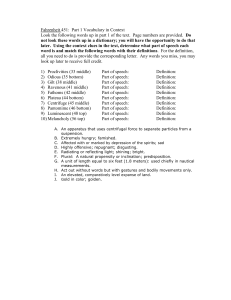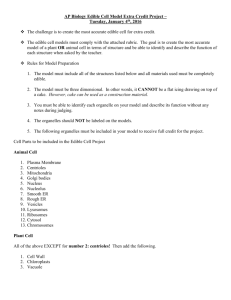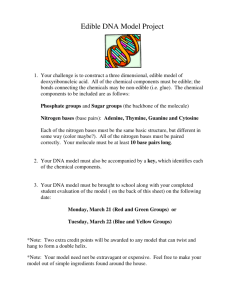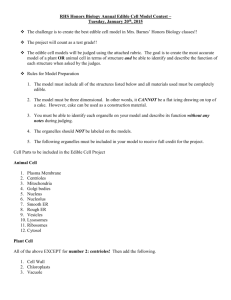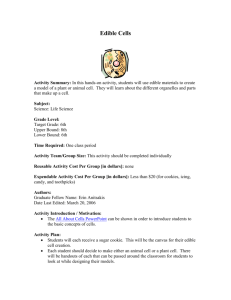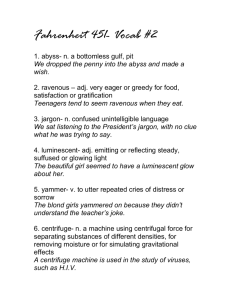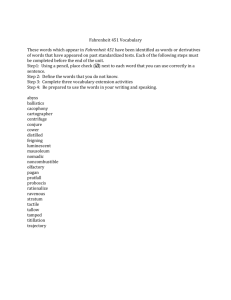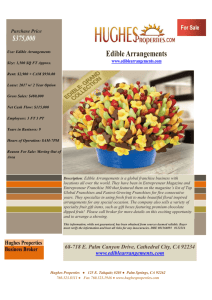File - Falling Between The Cracks
advertisement
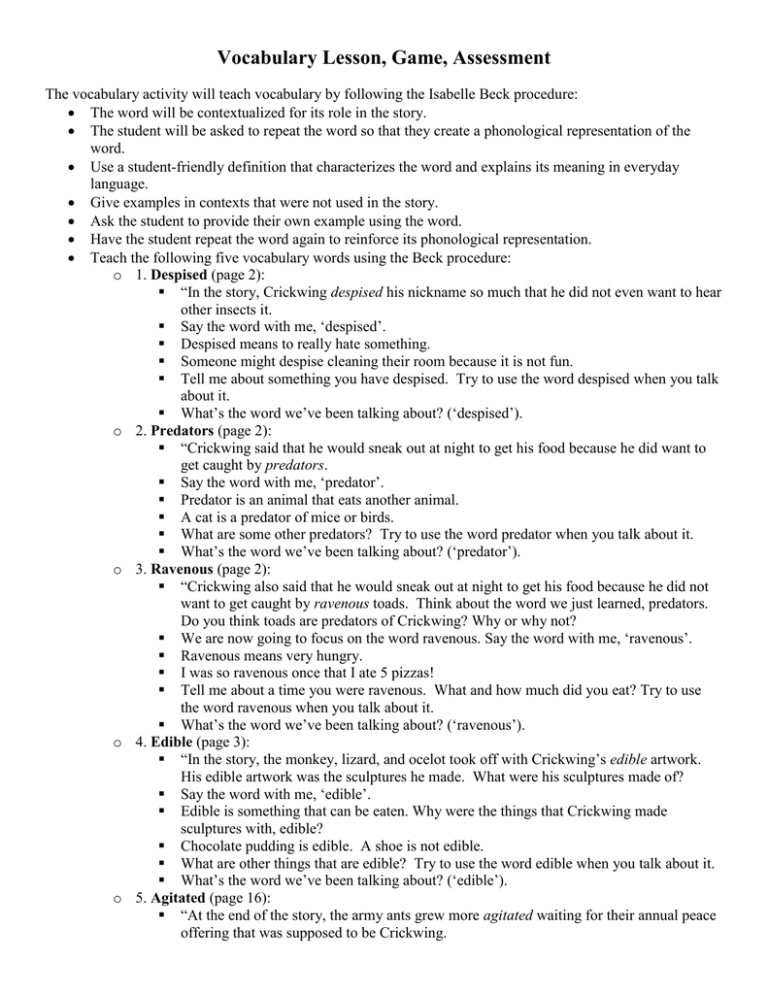
Vocabulary Lesson, Game, Assessment The vocabulary activity will teach vocabulary by following the Isabelle Beck procedure: The word will be contextualized for its role in the story. The student will be asked to repeat the word so that they create a phonological representation of the word. Use a student-friendly definition that characterizes the word and explains its meaning in everyday language. Give examples in contexts that were not used in the story. Ask the student to provide their own example using the word. Have the student repeat the word again to reinforce its phonological representation. Teach the following five vocabulary words using the Beck procedure: o 1. Despised (page 2): “In the story, Crickwing despised his nickname so much that he did not even want to hear other insects it. Say the word with me, ‘despised’. Despised means to really hate something. Someone might despise cleaning their room because it is not fun. Tell me about something you have despised. Try to use the word despised when you talk about it. What’s the word we’ve been talking about? (‘despised’). o 2. Predators (page 2): “Crickwing said that he would sneak out at night to get his food because he did want to get caught by predators. Say the word with me, ‘predator’. Predator is an animal that eats another animal. A cat is a predator of mice or birds. What are some other predators? Try to use the word predator when you talk about it. What’s the word we’ve been talking about? (‘predator’). o 3. Ravenous (page 2): “Crickwing also said that he would sneak out at night to get his food because he did not want to get caught by ravenous toads. Think about the word we just learned, predators. Do you think toads are predators of Crickwing? Why or why not? We are now going to focus on the word ravenous. Say the word with me, ‘ravenous’. Ravenous means very hungry. I was so ravenous once that I ate 5 pizzas! Tell me about a time you were ravenous. What and how much did you eat? Try to use the word ravenous when you talk about it. What’s the word we’ve been talking about? (‘ravenous’). o 4. Edible (page 3): “In the story, the monkey, lizard, and ocelot took off with Crickwing’s edible artwork. His edible artwork was the sculptures he made. What were his sculptures made of? Say the word with me, ‘edible’. Edible is something that can be eaten. Why were the things that Crickwing made sculptures with, edible? Chocolate pudding is edible. A shoe is not edible. What are other things that are edible? Try to use the word edible when you talk about it. What’s the word we’ve been talking about? (‘edible’). o 5. Agitated (page 16): “At the end of the story, the army ants grew more agitated waiting for their annual peace offering that was supposed to be Crickwing. Say the word with me, ‘agitated’. Agitated means to be angry or annoyed about something or someone Some students are agitated when they have to do homework. Tell me about something or someone that agitated you. Try to use the word agitated when you talk about it. What’s the word we’ve been talking about? (‘agitated’). After reading, use one context for all of the vocabulary words. For example: o “Do you think peas are edible? Why or why not? o Do you despise eating peas? Why or why not? o What if you were ravenous and had nothing left to eat except peas, would you eat them? Why or why not? o Do you get agitated when your parents tell you have to eat your peas? Why or why not? o Do you think predators would eat peas? Why or why not?” The book also contains other words that you could briefly explain so that the children can better understand the story. You can use student friendly definitions and/or visual aid from the illustration to define the words: o “Toil (page 1): means to work really hard. In the story, Crickwing said the leafcutting ants toil all day. They work hard all day. o Cowering (page 3): means to crouch or curl up because you are scared of something. Crickwing was cowering under a log from the monkey because he was scared. o Crevice (page 6): means a small crack or opening. Look at the picture, Crickwing is in a small space and the ocelot is looking at him through the crevice. o Exoskeleton (6): is the hard outer structure that provides protection for an insect. Crickwing has a hard outer layer that can protect him. o Dastardly (page 9): is something or someone that is mean or sneaky. Crickwing had a dastardly or sneaky idea. o Molecules (page 10): are very tiny objects that can’t be seen by only your eye. Crickwing is saying that compared to his size, the ants seem to be very small. Look at this picture and you can see how small the ants look.” Vocabulary Activity: The students will play a modified “go-fish” game with the vocabulary terms. Two different types of cards have been created: cards with the vocabulary word and a representative picture and then cards with the definition. Each student will get ten cards, with a random assortment of the two types of cards. Students can be put in pairs or can involve a small group. Because there are only 5 items the students are matching, tell the students that they cannot match within their own cards that they are holding. They must find someone else that has the matching card. Each student can earn a sticker for each correct match. You can instruct the students to use a script when asking for the cards to ensure that they are connecting the word with the definition. o An example script could be: Student 1: Do you have a card that means “to be really hungry”? Student 2: Yes, here is “ravenous” which means to be really hungry. Student 1: Do you have the definition for the word “agitated”? It means to be really angry or annoyed about something. Student 2: Yes, I have the definition for “agitated”. It means to be really angry or annoyed about something. o After a student finds a match, they should attempt to use that word in a sentence that they create. They could then receive a sticker for using the word correctly. Vocabulary Assessment: After the vocabulary activity, you will give the students an assessment to determine if they mastered the new vocabulary words. The instructions I have outlined will show at what level the student is able to define the words: recalling the definition, matching with the written definition, matching with a representative picture, and/or using the word accurately in a given sentence. o Give the students the worksheet that asks them to write the definition next to each word. If they are able to do this, provide them with the worksheet that asks them to fill in the blank using each of the vocabulary words. o If the student was not able to provide the definition for the word, provide them with the worksheet that asks them to match the word with the definition. If they are able to match the word with the definition, then provide them with the worksheet that asks them to fill in the blank using each of the vocabulary words. o If the student was not able to match the word with the definition, provide them with the worksheet that asks them to match the word with the picture. Next, have the student again try to match the word with the definition. Then, have the student try to do the fill in the blank worksheet. Despised Ravenous Predator Agitated Edible Despised Ravenous Predator Agitated Edible To really hate something To be really hungry An animal that eats another animal To be angry or annoyed about something Something that can be eaten To really hate something To be really hungry An animal that eats another animal To be angry or annoyed about something Something that can be eaten Please tell me the definition of each word. 1. Despised: _______________________________________________ ________________________________________________________ 2. Ravenous: _______________________________________________ ________________________________________________________ 3. Predator: ________________________________________________ ________________________________________________________ 4. Agitated: ________________________________________________ ________________________________________________________ 5. Edible: _________________________________________________ ________________________________________________________ Draw a line between the word and definition that matches. Despised Something that can be eaten Ravenous To really hate something Predator To be angry or annoyed about something Agitated To be really hungry Edible An animal that eats another animal Draw a line between the word and picture that matches. Despised Ravenous Predator Agitated Edible Use the words in the Word Box to fill in the blanks in the sentences. Word Box Despised Edible Ravenous Predator Agitated 1. I am so ______________ that I think I could eat a whole turkey! 2. Cleaning my room makes me _________________. 3. A snake is a _______________ because it eats mice. 4. When I was little, I _____________ mowing the lawn. 5. You should not eat glass because it is not ______________.
